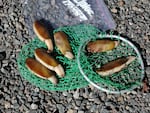A week after closing mussel harvesting across the Oregon Coast due to high levels of toxins, officials expanded that closure to include razor and bay clams.
Oregon’s departments of Agriculture and the state Fish and Wildlife jointly announced the closure Thursday.
The agencies said people should avoid the types of shellfish because of unprecedented levels of toxins caused by some species of algae.
Oregon health officials last week documented at least 20 people who have experienced paralytic shellfish poisoning from eating contaminated mussels. They launched a survey where people could document their health symptoms after consuming shellfish from the Oregon Coast, but as of Friday morning, that survey was closed.
Crab harvesting remains open to the public, but health officials recommend gutting or eviscerating the crustaceans before cooking. State officials have also closed commercial oyster fisheries in Tillamook Bay, Netarts Bay and Umpqua Bay.
While they are not sampling scallops for biotoxins at this time, state officials advise people not to eat whole scallops because they could contain biotoxins. The scallop adductor muscle does not build up biotoxins and may be safe to eat.

FILE: Razor clams are particularly susceptible to toxic domoic acid accumulation.
Courtesy of NOAA
Paralytic shellfish poisoning is among the most serious that stems from shellfish. It can cause numbness in the limbs, upset stomach and in severe cases, paralysis.
Paralytic shellfish poisoning is caused by eating shellfish contaminated with naturally occurring saxitoxins. Many kinds of shellfish can be contaminated by saxitoxins, but they most often affect mussels and clams.
Cooking shellfish will not destroy these poisonous biotoxins. There is no antidote for biotoxin poisoning. If someone starts to experience symptoms, they should contact their doctor.
Toxins in coastal shellfish are becoming more common as a result of warming waters due to climate change. They are tied to algal blooms in the ocean. These blooms are colloquially called “red tides” or “brown tides,” though they don’t always color the water.
